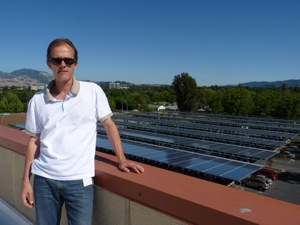Technology, yes. Policy, yes. Manufacturing…maybe not so much
This week as Fremont-based Solyndra sets about the grim business of filing for Chapter 11 bankruptcy, it leaves in its wake ample confusion over California’s much vaunted “lead” in renewable energy — so much so that last week a national solar industry association felt compelled to issue a statement reassuring us that Solargeddon was not at hand. (Cy Musiker’s interview with Sev Borenstein of UC Berkeley’s Energy Institute provides some solid perspective on the Solyndra collapse).
It didn’t help that Solyndra had been the arc light of California’s renewable power surge. President Obama, Energy Secretary Steve Chu and former Governor Arnold Schwarzenegger had all led media parades through the company’s Fremont manufacturing plant. The bankruptcy announcement came within hours after Chu finished extolling California’s leadership at an energy “summit” in Las Vegas.

Recently I climbed to the roof of the Contra Costa County Office of Education with John Hild, for an overview of a new 700-panel solar array that covers the agency’s parking lot in Concord.
Hild, who manages facilities there, was impressed with the May electric bill, which had dropped to $19 from about $7,200 before the photovoltaic (PV) panels were hooked up. But Hild says it was tough to find American-made panels, something required by one of the incentive programs that CCCOE was tapping into to make the project affordable. In the end, they found some–but they were made in Arizona, not California, by the Chinese solar juggernaut SunTech.
At the same time that Solyndra was burning through federal stimulus dollars to gain traction with a new panel technology, SunTech and others were cranking out standard-technology panels, bringing the price down dramatically — 30% in 2011 alone, according to the Solar Energy Industries Association (SEIA).
A few months ago, when I interviewed SunTech founder and CEO Zhengrong Shi, he said he doesn’t see China and California in competition. “We still need to buy raw materials from all over the world,” Shi told me. He said facilities like SunTech’s Phoenix operation could provide the impetus for manufacturing hubs. “[Components] manufacturers can put their factories next to our factory,” Shi said. “I think that way [it will] make the whole industry grow much faster. Manufacturing costs will come down because all materials…will be produced locally.”
A recent report from SEIA touted the US as a net exporter of “solar energy products.” But the bulk of that is polysilicon, the basic feedstock for fabrication of PV panels, not the finished panels.
While the SEIA report makes its case for a robust US-based industry, total investment in clean energy flows increasingly eastward. A parsing of the $243 Billion global investment pie by the Pew Charitable Trusts showed China leading all contenders in 2010 with $54.4 Billion (a 39% jump from 2009) $243 Billion. The US fell to third with $34 B (global investments in the solar sector were up by more than half).
In the end, Shi may be right in his assertion that there’ll be plenty of room for everybody. A new report from the South Korean electronics giant, Samsung projects the global market for solar panels to more than double by 2020. But right before Labor Day and overshadowed by the Solyndra hysteria, the German manufacturer SolarWorld announced that it, too, was shutting down production at a California plant and moving the work to Oregon, where labor costs are lower.
California’s policies have helped to create a steady market. California’s labs might provide the next game-changing solar breakthrough (which Shi says is likely ten years off). But with the basic rooftop hardware rapidly becoming a commodity, current trends would seem to cast doubt on California’s place in the sun as a world-beating producer of solar panels.
